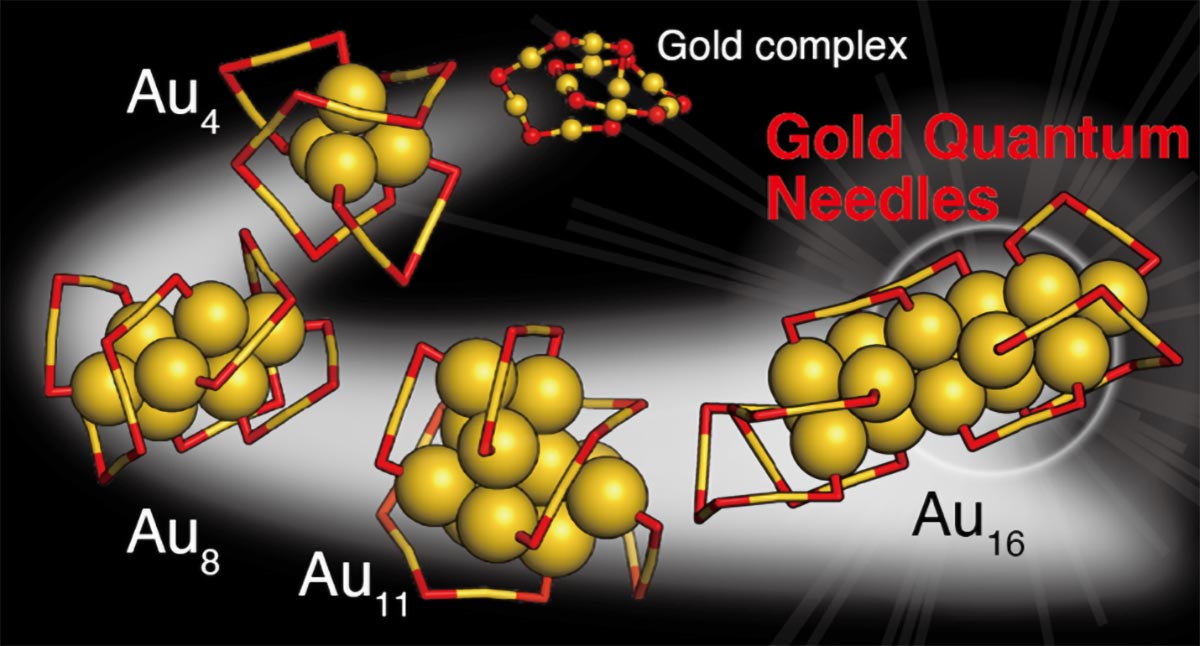Potential applications range from biomedical imaging to the conversion of light energy.
University of Tokyo researchers Shinjiro Takano, Yuya Hamasaki, and Tatsuya Tsukuda have directly imaged how the geometric arrangement of atoms in gold nanoclusters develops at the very earliest stages of growth.
Under the same conditions, the team also “grew” an unexpected elongated nanocluster structure that they named “gold quantum needles.” Because these “needles” respond strongly to near-infrared light, they could enable much sharper biomedical imaging and more effective light-energy conversion. The findings were reported in the Journal of the American Chemical Society.
Gold may evoke luxury, yet at the nanoscale, it is a vital material in modern technology because it forms unusual structures with distinct properties. Gold nanoclusters with fewer than 100 atoms are typically produced by reducing, that is, adding electrons, gold precursor ions in the presence of protective ligands. Despite this, achieving precise control over size, shape, and composition remains difficult.
Opening the “Black Box” of Cluster Formation
“Over the past years,” says Tsukuda, the principal investigator, “much effort has been devoted to understanding the correlation between the structure and physicochemical properties of the nanoclusters. However, the formation process is regarded as a black box. We initiated this project with the belief that understanding the initial stages of cluster formation will lead to the development of new, targeted synthesis methods for desired structures.”
The researchers thus set out to determine the geometric structures of gold nanoclusters at the initial stages of their formation. They used slightly unusual synthesis conditions to trap the nanoclusters in the very first stages of growth. Single-crystal X-ray diffraction analysis, an X-ray for chemical compounds, if you will, revealed that gold nanoclusters grew anisotropically, at a different rate in different directions.
The Discovery of Gold Quantum Needles
Moreover, the analysis revealed an entirely new structure: pencil-shaped nanoclusters composed of triangular trimers and tetrahedral tetramers. The researchers named them “gold quantum needles” because the electrons confined in these nanoclusters demonstrated quantized behavior, a quantum phenomenon in which electrons can take only specific potential energies.
“We could retroactively explain the formation processes of a series of small gold nanoclusters under our unusual synthetic conditions,” Tsukuda explains. “However, the formation of needles with a base of a triangle of three gold atoms instead of a nearly spherical cluster is a serendipitous finding that was far beyond our imagination.”
The structural snapshots the researchers acquired of the stepwise growth of gold nanoclusters greatly contribute to our understanding of the formation mechanism. However, Tsukuda is already thinking about the next steps.
“We would like to explore synthesizing other, unique nanoclusters by refining the synthesis conditions further. We would also like to collaborate with other experts to promote the application of gold quantum needles, leveraging their exceptional optical properties.”
Reference: “X-ray Crystallographic Visualization of a Nucleation and Anisotropic Growth in Thiolate-Protected Gold Clusters: Toward Targeted Synthesis of Gold Quantum Needles” by Shinjiro Takano, Yuya Hamasaki and Tatsuya Tsukuda, 4 September 2025, Journal of the American Chemical Society.
DOI: 10.1021/jacs.5c11089
Never miss a breakthrough: Join the SciTechDaily newsletter.
Source link
